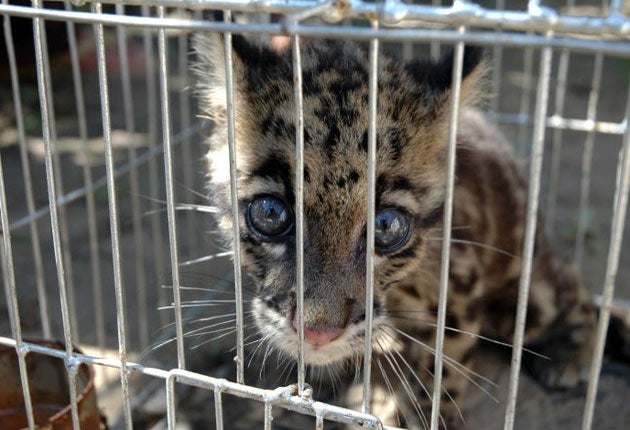Villagers discover 'extinct' leopard cub eating a monkey

Your support helps us to tell the story
From reproductive rights to climate change to Big Tech, The Independent is on the ground when the story is developing. Whether it's investigating the financials of Elon Musk's pro-Trump PAC or producing our latest documentary, 'The A Word', which shines a light on the American women fighting for reproductive rights, we know how important it is to parse out the facts from the messaging.
At such a critical moment in US history, we need reporters on the ground. Your donation allows us to keep sending journalists to speak to both sides of the story.
The Independent is trusted by Americans across the entire political spectrum. And unlike many other quality news outlets, we choose not to lock Americans out of our reporting and analysis with paywalls. We believe quality journalism should be available to everyone, paid for by those who can afford it.
Your support makes all the difference.Conservationists in Bangladesh are celebrating after remote tribespeople discovered a rare and threatened leopard that was believed to have been extinct in the country for almost 20 years.
Villagers in the Chittagong Hill Tracts in south-east Bangladesh captured the clouded leopard cub after they disturbed it, its sibling and their mother eating a dead monkey in the jungle. The others escaped, but the villagers captured the three-month-old and put it in a cage. It is understood the tribespeople planned to sell the animal but, after news of the discovery spread, conservationists persuaded them to release the leopard back into the wild. They did so yesterday.
"We are delighted. For many years now, we had thought this animal was gone or was going," said Professor Anwarul Islam, head of the Wildlife Trust of Bangladesh. "It's good to know that they are still there and that they are breeding."
The clouded leopard, which famously has large dark patterns on its coat, is considered vulnerable across all of south-east Asia, with loss of habitat through deforestation and the Chinese trade in rare animal parts being blamed for the decline.
Listed as critically endangered by the International Union for Conservation of Nature, there are an estimated 100,000 living worldwide. Reports suggest that the last sighting of the shy and nocturnal animal in Bangladesh was in 1992.
Mr Islam said the villagers in an area of south-east Bangladesh bordering Burma and the north-east Indian state of Mizoram, had stumbled on the family of animals three weeks ago. They took the cub to their village, where it was fed on chicken and milk. The villagers were anxious about releasing the animal as they feared it would struggle to survive in the wild without its mother.
But Mr Islam said the fact that the leopard had a healthy appetite was a good sign. "Most wild animals do not like to eat in captivity but this cub was eating chickens," he said. "The villagers also tried to feed it milk but apparently he preferred the meat."
Environmentalists have long been on the losing side of a battle in Bangladesh, a desperately poor country where conservation has seldom seemed a priority.
In recent years, however, awareness has grown and organisations such as the Bangladesh Environmental Lawyers Association (Bela) have campaigned for the enforcement of orders by the country's courts on issues such as forest protection.
Clouded leopards are notoriously difficult to breed in captivity. There is a breeding programme under way involving zoos in Thailand and the US, and three baby leopards were recently born at the Nashville Zoo.
Christine Breitenmoser-Würsten, a Swiss specialist on large cats who works with the World Conservation Union, said the threat to the clouded leopard varied from location to location. In Burma and southern China local people still hunted the cats for food while elsewhere, pelt-hunters and destruction of habitat represented the biggest danger. Of the discovery of the cub in Bangladesh, she said: "It's very exciting – it's fascinating. I was thrilled when I heard about it."
Join our commenting forum
Join thought-provoking conversations, follow other Independent readers and see their replies
Comments